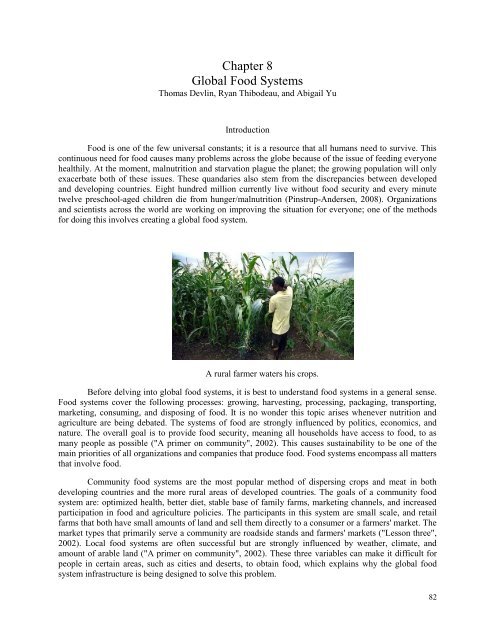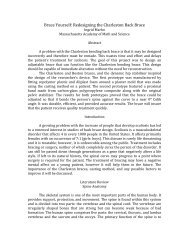Got Food? - the Scientia Review
Got Food? - the Scientia Review
Got Food? - the Scientia Review
Create successful ePaper yourself
Turn your PDF publications into a flip-book with our unique Google optimized e-Paper software.
Chapter 8<br />
Global <strong>Food</strong> Systems<br />
Thomas Devlin, Ryan Thibodeau, and Abigail Yu<br />
Introduction<br />
<strong>Food</strong> is one of <strong>the</strong> few universal constants; it is a resource that all humans need to survive. This<br />
continuous need for food causes many problems across <strong>the</strong> globe because of <strong>the</strong> issue of feeding everyone<br />
healthily. At <strong>the</strong> moment, malnutrition and starvation plague <strong>the</strong> planet; <strong>the</strong> growing population will only<br />
exacerbate both of <strong>the</strong>se issues. These quandaries also stem from <strong>the</strong> discrepancies between developed<br />
and developing countries. Eight hundred million currently live without food security and every minute<br />
twelve preschool-aged children die from hunger/malnutrition (Pinstrup-Andersen, 2008). Organizations<br />
and scientists across <strong>the</strong> world are working on improving <strong>the</strong> situation for everyone; one of <strong>the</strong> methods<br />
for doing this involves creating a global food system.<br />
A rural farmer waters his crops.<br />
Before delving into global food systems, it is best to understand food systems in a general sense.<br />
<strong>Food</strong> systems cover <strong>the</strong> following processes: growing, harvesting, processing, packaging, transporting,<br />
marketing, consuming, and disposing of food. It is no wonder this topic arises whenever nutrition and<br />
agriculture are being debated. The systems of food are strongly influenced by politics, economics, and<br />
nature. The overall goal is to provide food security, meaning all households have access to food, to as<br />
many people as possible ("A primer on community", 2002). This causes sustainability to be one of <strong>the</strong><br />
main priorities of all organizations and companies that produce food. <strong>Food</strong> systems encompass all matters<br />
that involve food.<br />
Community food systems are <strong>the</strong> most popular method of dispersing crops and meat in both<br />
developing countries and <strong>the</strong> more rural areas of developed countries. The goals of a community food<br />
system are: optimized health, better diet, stable base of family farms, marketing channels, and increased<br />
participation in food and agriculture policies. The participants in this system are small scale, and retail<br />
farms that both have small amounts of land and sell <strong>the</strong>m directly to a consumer or a farmers' market. The<br />
market types that primarily serve a community are roadside stands and farmers' markets ("Lesson three",<br />
2002). Local food systems are often successful but are strongly influenced by wea<strong>the</strong>r, climate, and<br />
amount of arable land ("A primer on community", 2002). These three variables can make it difficult for<br />
people in certain areas, such as cities and deserts, to obtain food, which explains why <strong>the</strong> global food<br />
system infrastructure is being designed to solve this problem.<br />
82
















